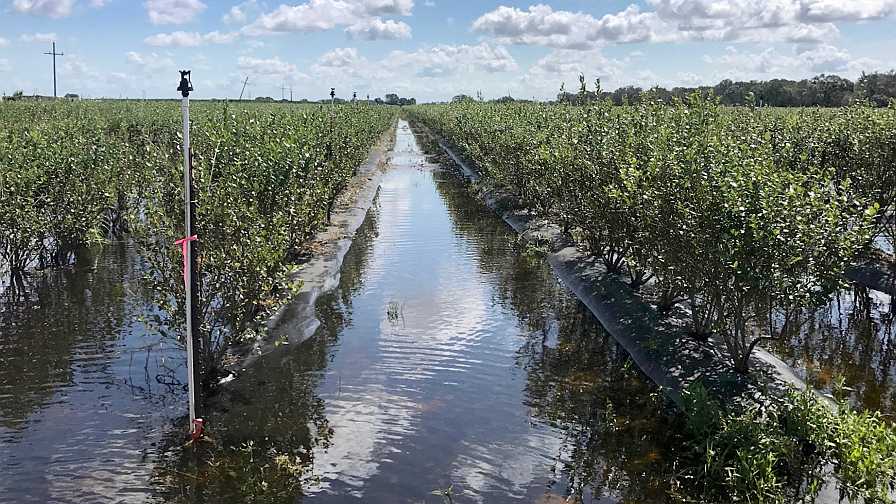How To Handle Blueberry Crop Damage Assessments After the Storm

Wind and rain can do a number on blueberry plants during tropical storms and hurricanes.
Photo courtesy of UF/IFAS
Hurricane Ian not only delivered devastating winds and storm surge when it slammed into Florida, but also epic rainfall across much of the state. It was not uncommon for some areas to have gotten more than a foot of rain from the storm. These harsh conditions can do a number on food crops — some more than others. The wind and rain can damage blueberry plants in a number of ways. Some of these issues can be rehabbed, but in more severe cases, plants or orchards might need to be replaced. So, what to do? UF/IFAS provides guidance to growers on how to assess damage after the storm in a report titled “Impacts of Hurricane Damage on Southern Highbush Blueberries.”
Wind Damage
Tropical storm or hurricane-force wind can cause significant damage to plants. Defoliation can have a significant impact on blueberry production even before there are blossoms or fruit on the plants. Flower bud number is the most important characteristic of yield in blueberries. This is determined by the amount of flower bud initiation and development that takes place in late summer and fall, which depends on plants having a full and healthy canopy of foliage.
Early fall (September and October) defoliation of southern highbush blueberries reduces the number of flower buds that develop and/or the number of fruit produced per flower bud, and it can also affect bloom time. The impact of defoliation on yield could be even more significant on blueberry plants grown in an evergreen system, where it is important to maintain healthy foliage throughout the fall, winter, and early spring to support the next year’s crop and to achieve early yields of high-quality fruit. The blueberry defoliation that can occur during a hurricane can thus have a major impact on the following season’s yield.
Winds also may uproot plants, which may require resetting or staking existing plants. Damaged plants that are salvaged may suffer from impaired nutrient and water uptake and be more susceptible to disease.
Flooding
The heavy, prolonged rains that come with tropical systems often result in a number of problems in orchards because blueberry plants do not tolerate saturation well. Typical outcomes of flooding include root death and conditions ripe for diseases like Phytophthora root rot and the water mold pathogen Phytophthora cinnamomi. Flooding also can reduce root and shoot growth, reduce leaf number, inhibit leaf expansion, increase leaf abscission, reduce nutrient uptake, and result in smaller flower buds and fruit.
Recovery Recommendations
After the storm, the key is to reduce plant stress as much as possible. Reset and stake uprooted, lodged plants as quickly as possible to reduce losses from desiccation and plant death. Examine irrigation systems to make sure that when waters recede, the system is functioning properly. After the storm and rains pass, carefully monitoring irrigation will be critical to preventing further drought stress in plants with damaged root systems. Repair raised beds and weed cloth, and resume bed irrigation and pH monitoring, adjusting as necessary. Resume scheduled fertilizer applications after waters have receded and when beds begin to drain but consider reducing rates of nitrogen where plants have been stressed, slowly returning to recommended timings and rates for the given deciduous or evergreen production system.
Another important practice is to resume scouting for disease symptoms and insect pests and to begin to apply management and control recommendations as appropriate. Ideally, applications of Ridomil (Syngenta) or another mefenoxam fungicide for Phytophthora root rot prevention will have already been made in early summer prior to hurricane activity. Two applications of these products per year are allowed, and where a second application was not made earlier, consider making that application prior to a predicted storm impact where possible. When not possible, the second application can be made after waters have receded, either in a banded bed application or through certain irrigation systems (consult the product label for specifics). These applications can help prevent root rot development, but they will not cure plants severely affected or those dying from flooding (hypoxia).










